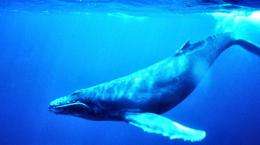Multi-tasking whales sing while feeding, not just breeding

Humpback whales are famed for their songs, most often heard in breeding season when males are competing to mate with females. In recent years, however, reports of whale songs occurring outside traditional breeding grounds have become more common. A new study may help explain why.
Humpbacks sing for their supper—or at least, they sing while they hunt for it.
The research, published December 19 in PLoS ONE, uncovers the whales' little-understood acoustic behavior while foraging.
It also reveals a previously unknown behavioral flexibility on their part that allows the endangered marine mammals to balance their need to feed continuously with the competing need to exhibit mating behaviors such as song displays.
"They need to feed. They need to breed. So essentially, they multi-task," said study co-author Ari S. Friedlaender, research scientist at Duke University's Nicholas School of the Environment. "This suggests the widely held behavioral dichotomy of breeding-versus-feeding for this species is too simplistic."
Researchers from the U.S. Naval Postgraduate School, the University of California-Santa Barbara and Duke tracked 10 humpback whales in coastal waters along the Western Antarctic Peninsula in May and June 2010. The peninsula's bays and fjords are important late-season feeding grounds where humpbacks feast on krill each austral autumn before migrating to warm-water calving grounds thousands of miles away.
Using non-invasive multi-sensor tags that attach to the whales with suction cups, the researchers recorded the whales' underwater movements and vocalizations as they foraged.
All 10 of the tags picked up the sounds of background songs, and in two cases, they recorded intense and continuous whale singing with a level of organization and structure approaching that of a typical breeding-ground mating display. The song bouts sometimes lasted close to an hour and in one case occurred even while sensors indicated the whale, or a close companion, was diving and lunging for food.
Humpbacks sing most frequently during breeding season, but are known to sing on other occasions too, such as while escorting mother-calf pairs along migratory routes. Though the reasons they sing are still not thoroughly understood, one distinction is clear: Songs sung in breeding grounds are quite different in duration, phrase type and theme structure from those heard at other locations and times.
"The fact that we heard mating displays being sung in late-season foraging grounds off the coast of Antarctica suggests humpback whale behavior may be more closely tied to the time of year than to physical locations. This may signify an ability to engage in breeding activities outside their traditional warm-water breeding grounds," said Douglas P. Nowacek, Repass-Rogers University Associate Professor of Conservation Technology at Duke's Nicholas School.
As the region's climate warms, sea ice cover around the Western Antarctic Peninsula has thinned in recent years and the water stays open later in the foraging season, he explained. Whales are remaining there longer into austral autumn to feast on krill instead of heading off to warm-water breeding grounds, as many scientists previously believed.
"Mating may now be taking place at higher latitudes," Nowacek said. "This merits further study."
Alison K. Stimpert, research associate in oceanography at the Naval Postgraduate School, was lead author of the new study. Lindsey E. Peavey, a PhD Student at the University of California at Santa Barbara's Bren School of Environmental Science and Management, co-authored it with Stimpert, Friedlaender and Nowacek.
More information: "Humpback Whale Song and Foraging Behavior on an Antarctic Feeding Ground," Alison K. Stimpert, U.S. Naval Postgraduate School; Lindsey E. Peavey, University of California-Santa Barbara; Ari S. Friedlaender, Duke University; Douglas P. Nowacek, Duke University. PLoS ONE, Dec. 19, 2012. dx.plos.org/10.1371/journal.pone.0051214
Journal information: PLoS ONE
Provided by Duke University


















